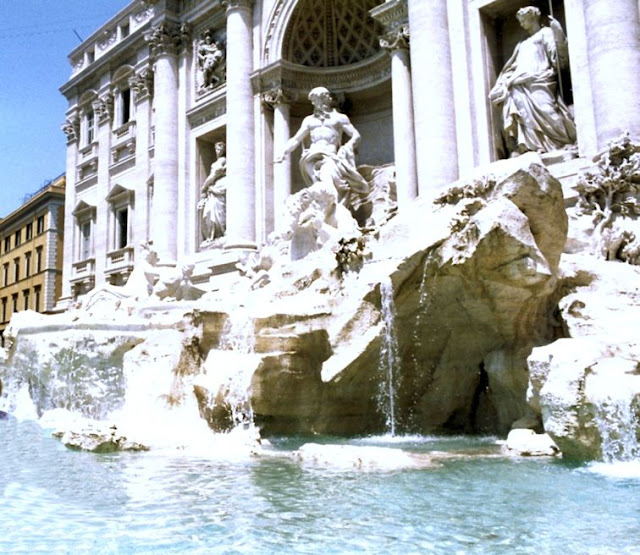Another underground wonder in Rome
The Fontana di Trevi (Trevi Fountain) is probably the most famous fountain in Rome. Its name comes from the “tre vie” (three streets) that intersect here. The films Three Coins in the Fountain and La Dolce Vita have popularized it on an international scale.
Finished on a design in the late Baroque style of the Roman architect Nicola Salvi in 1762, the work is a tribute to water. The composition is dominated by an imposing Neptune on a cart formed by an enormous shell, pulled by two horses. The triton on the left tries to control his agitated horse which symbolizes the stormy ocean, while the one on the right blows through a shell while guiding his horse easily, representing calm waters. The sense of movement and enormity is amplified by the small square that the structure occupies.
The custom of throwing a coin over your shoulder into the
fountain, to assure your return to Rome, is celebrated and photographed at all
hours of the day and night by people from all over the world
The Trevi Fountain
The visit to the basement of the Trevi Fountain is a less known but at the same time incredibly suggestive tourist route. It is well known that everywhere in Rome you can find ancient domus, aqueducts and archaeological finds. The site under the Trevi Fountain is a prominent example of this and deserves to be visited.

Buildings under the fountain
The Vicus Caprarius, “the city of water”
The term “City of Water”, used commonly to define the archaeological area of Vicus Caprarius beneath the Trevi Fountain is due to the element that without doubt characterizes the area and the site. It was discovered between 1999 and 2001 during the renovation of the former Trevi Cinema.
Thanks to the excavations carried out together with the superintendence of the archaeological heritage of Rome, a building complex of the imperial age was brought to light, including canals that carried water from the Acqua Virgo to the luxurious domus of the area, in which water still flows from the Lucullan countryside at a depth of 9 meters below the level of the road.
The antiquarium
To frame the archaeological site there is the antiquarium, that is the exhibition of all the finds that have been found over the years during the excavations. There are over 800 coins dating back to between the 4th and 5th centuries AD, as well as everyday objects, including terra-cotta figurines, African pottery, and mosaic tiles.

Pottery found in the area, with coins
What makes this hidden gem particularly special, however, is the water that runs through it. At Vicus Caprarius, visitors will find pools that still fill with water, thanks to the Aqua Virgo, one of the 11 aqueducts of ancient Rome. This aqueduct is also the one that feeds into the Trevi Fountain, meaning the water you see in Vicus Caprarius will eventually make its way to the fountain for tourists to throw their coins in.
The excavations brought to light an imposing distribution tank, (the castellum aquae) and the water, which filters through the ancient masonry of the Archaeological area, continues to supply the pipes in lead and the pools of a luxurious residence.
The wall structures found, characterized by a brick facing and conserved until a height of about eight meters, are attributed to an insula, a housing block divided into several independent units that were transformed, in the middle of the fourth century, into a stately domus.
Tickets for this archaeological site are only four euros (about $4.08 USD). For more information on how to visit, check out the official website. There are numerous companies that provide tours, but you can also go on your own.



No comments:
Post a Comment